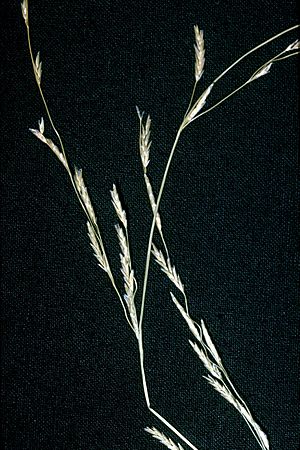Northern mannagrass facts for kids
Quick facts for kids Northern mannagrass |
|
|---|---|
 |
|
| Scientific classification | |
| Genus: |
Glyceria
|
| Species: |
borealis
|
| Synonyms | |
|
Panicularia borealis |
|
Glyceria borealis is a special kind of grass known by a few cool names like northern mannagrass, boreal mannagrass, or small floating mannagrass. This plant is found all over the northern parts of North America, from Canada down into the United States. It's a plant that loves water, so you'll often find it growing in very wet places, especially in mountain forests, sometimes even right in the water!
What is Northern Mannagrass?
Northern mannagrass is a fascinating plant that belongs to the Glyceria family. It's known as a "semiaquatic" plant, which means it's happy living partly in water and partly on land. Imagine a plant that can grow tall and straight, or even float on the surface of a pond or stream! That's exactly what this grass does. It's an important part of the natural environment in the wet areas where it grows.
Where Does Northern Mannagrass Live?
This unique grass is native to a huge area across the northern half of North America. You can find it in many different places, from the cool forests of Canada to various parts of the United States. It especially likes wet spots in mountain forests. Think about marshy areas, edges of ponds, slow-moving streams, or even flooded meadows – these are all places where northern mannagrass feels right at home. It needs a lot of moisture to thrive, which is why it's always near water.
What Does Northern Mannagrass Look Like?
Northern mannagrass has a very interesting appearance.
- Stems: Its stem is usually tall and quite thin. It can often grow taller than a meter (about 3 feet)! Sometimes, the stem stands up straight, but it can also bend over, lie flat on the ground, or even float on the water. This helps it adapt to different water levels.
- Leaves: The leaves of this grass have a special part called a ligule. A ligule is a small, thin flap of tissue where the leaf blade meets the stem. For northern mannagrass, these ligules can be up to a centimeter long.
- Flowers and Seeds: The plant produces a long, narrow cluster of flowers called an inflorescence. This is like the plant's flower head. Inside this inflorescence, you'll find small, tube-shaped parts called spikelets. Each spikelet is usually one to two centimeters long and holds about 6 to 11 tiny flowers, which are called florets. These florets have thin, almost see-through edges. After the florets are pollinated, they will develop into seeds, helping the plant to reproduce and spread.

